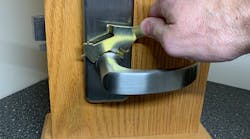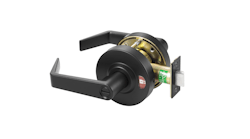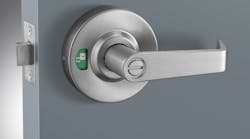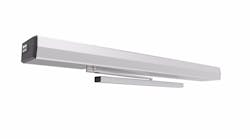If you're getting into electronic access control installations, it's inevitable that at some point you will be required to perform some form of what is referred to as "programming".
 A large selection of access control products are available these days, making it possible for the locksmith to decide which products he will get involved with based on the attributes of the system as well as how the unit is programmed. Many locksmiths do not use computers, just as there are many customers who feel their lives are rich enough without adding system crashes and hard drives and software and hackers.
A large selection of access control products are available these days, making it possible for the locksmith to decide which products he will get involved with based on the attributes of the system as well as how the unit is programmed. Many locksmiths do not use computers, just as there are many customers who feel their lives are rich enough without adding system crashes and hard drives and software and hackers.
Regardless of the access control system you install, certain parameters (programmable system operating features) must be "entered" into the system, and there are many different ways to do the entering, depending on the system.
These systems are all still essentially locks, and they all have many things in common, although manufacturers may try to distinguish their product with a unique look or terminology.
Even the locksmith with a minimal aptitude and interest in learning will gain an understanding of the basics quickly. As he masters the hardware and software, his selection of products to offer his clients will become become a matter of convenience, taste and preference.
Management is Mandatory
As is the case with keys, access control credentials and access codes must be carefully managed and tracked to maintain security. Although the software and appliances used for some systems may require more time and commitment from the locksmith, these applications make system management infinitely easier and more precise an operation for the end-user.
The client must be made aware that there is more to security management of his site than bolting things to the door. Security management is a combination of physical and electronic security and a focused organized awareness.
With all of the systems out there to choose from, the locksmith at times may find his worst enemy his himself when proposing access control projects.
Earlier access controls systems were mechanical and "supported" (worked with) only one memorized code. Other systems were electronic, but also were able to support only one code. Sometimes one is enough to do the job, and these systems are still very popular.
Although the new systems are certainly feature rich, these features come at a price. You have to pay for the bells and whistles.
Many seasoned security buyers have learned the hard way or have been warned by peers. These clients will often opt for a simpler solution in order to:
- avoid investing in something that possibly be obsolete in a year.
- avoid spending on a system that offers features that are redundant to other equipment already on site.
- avoid taking on a system that will require a specialist to manage.
- avoid getting "duped" into buying a system that does more than he really wants.
I've fallen in love with a piece of equipment so much that it never occurred to me that a potential customer would not share my infatuation. But then the client called a few other locksmiths, and the other guy offering the "plain vanilla" system would get the project. So the locksmith must be acquainted with a range of products to meet different sets of requirements. Do not be a "One Trick Pony."
Some of the public wrongly perceive locksmiths as honest but not technically sophisticated, mechanically inclined but electronically challenged. And there are lots of fellow locksmiths and unscrupulous competitors out there who help perpetuate this misconception.
 The locksmith is the physical security specialist who brings with him the basic skill of knowing how to keep the door locked and keep the bad guys out, and the secondary ability to also control the door so only the right folks get through it. These are not the priorities of the other voltage trades.
The locksmith is the physical security specialist who brings with him the basic skill of knowing how to keep the door locked and keep the bad guys out, and the secondary ability to also control the door so only the right folks get through it. These are not the priorities of the other voltage trades.
So, therefore, it is wise for the locksmith to be prepared to offer a selection of products from which the customer can choose.
Clients frequently leap on the cheapest thing you offer and slowly talk themselves into the next level up. Or they're in panic state and want your "best" and then go into shock(faint from sticker shock) and rationally tone down their requirements to suit their budget.With access control systems, count on spending some additional time on the job first planning out the system then, later, training the client "programming".
With access controls, the system includes not only the lock you hang on the door, but also the electronics that control the lock and the set of instructions you "program" in to tell the electronics how to control the lock.
It's happened so many times to me. I'm feeling good about having gotten the unit onto the door in record time. I cleaned up the site, loaded my stuff on the truck, got the bill ready and then proudly presented it to the customer who says, "Now you're going to show me and all my staff how this thing works, right?"
Plan Ahead
Well in advance of the installation, make the client aware of all the information you will need to program the system. Who will be the authorized system users? When they will be permitted?
Depending on the system you are installing, you may be able to do most of the programming before you ever set foot on the job. This is helpful if your best installer is a great mechanic but a lousy electronic technician. You can do the programming to the system back in the shop and it will be ready to go as soon as it's mounted on the door.
Programming is not always entering data. Sometimes it involves moving configuration jumpers around, or setting DIP switches, or performing other ‘mechanical' steps in order for the lock to perform it job.
Access controls use codes, credentials and biometrics to determine the eligibility of the user to be permitted access. Access controls can also be used in conjunction with traditional key locks. Access control credentials can be cards or electronic devices, which look like keys, but are in fact small computer chips imbedded in key-shaped objects.
Biometric readers measure unique physical characteristics of the individual and verify the person's identity based on templates stored in the system memory. Biometric technology primarily uses fingerprints, retinal patterns, handprints, speech patterns and facial patterns for identity verification.
Card-type credentials are of several types: magnetic stripe, bar code, proximity, RF, Weigand, smart cards and biometric. Each technology offers specific benefits for particular applications.
PROGRAMMABLE ACCESS CONTROL SYSTEMS The following is a listing of programmable access control systems and manufacturer contact information: MARKS I-Que: Stand-alone access control programs from keypad or with I-Dat Download Module. Software is supplied on a CD. Audit Trail and many more software features. Quality Marks Lock mechanism, many optional finishes and adapters. http:///www.marksusa.com. IEI: One of the deepest lines of access controls available. Includes everything form stand-alones with keypad to networked "Secured Series Software" and systems and dial-up programming, audit trails, etc. http://www.ieib.com.ALARM LOCK Trilogy DL2800: Stand-alone access control with many options and features. Software on CD, may be programmed from keypad, handheld downloader, PC interface cable. Audit trails may be obtained using IR printer. Supports proximity card technology. http://www.napcosecurity.com.LOCKNETICS: Expansive line of computer-managed and keypad-programmable units including CM Series, PRO Series and PRO+ Series. CM Series are Stand-alones which are computer-programmed using LockLink. PRO & PRO+ are programmed from keypad and use separate keypad and controller. http://www.locknetics.com.SCHLAGE: COBRA is one of the smallest, newest and most attractive stand-alones which is programmed using the keypad and has a concealed key override. This product is a collaboration with LOCKNETICS. http://www.irsecurityandsafety.com.Schlage E-Bolt uses hybrid keys which can be cut liker a traditional key, but also contain a computer chip and are used in special E-Bolt readers as access credentials. Software is supplied on CD. Keys are programmed using an appliance which connects to a computer. E-Bolt locks are programmed, and activity logs are uploaded using the keys to shuttle the data. Keys may be cut and used in traditional locks as well as the E-Bolt locks. www.schlage.com. KABA MAS: PowerLever is a unique standalone keypad lock which is programmed via Palm Interface. Capacity is 3,000 users and 23,000-event audit trail. Software supplied on a CD. PowerLever is self-powered, so there are never any batteries to replace. http://www.kaba-mas.com. RCI EASYPROX: Rutherford Controls' EasyProx is a high-tech/low tech product which uses the popular proximity access control credential but does not require a computer to program. A dedicated deck of special cards are included with the unit, and the cards are used to do all the programming. http://www.rutherfordcontrols.com.OSI SECURITY DEVICES OM2000: The OMNILOCK Access Control System Series OM2000 is a stand- alone with hard-wired features — a 2,000-user system that will record the identity, date, and time of the last 5,000 events, including key bypass or tampering. The OFM(OMNILOCK Facility Manager), a Microsoft Windows®-compatible database program, can manage in excess of 65,000 individual users using a Windows CEI or Pocket PC. It is available weatherized and supports a card reader. http://www.omnilock.com.SARGENT: The Model KP10G77 Stand Alone Access Keypad lock is programmed from the keypad. The transaction log (audit trail) may be downloaded using an IR printer. Easy to program and very robust with commercial grade lock hardware. http://www.sargentlock.com.SECURITY DOOR CONTROLS E72EntryCheck stand-alone access control: This battery-powered unit provides controlled access for high-security applications with multi-level security requirements and is easily programmed at the keypad or with a computer. The E72 is a Grade 1, cylindrical lockset, which meets the UL three-hour fire rating and ADA requirements. Capacity is 64 users and a 50-event audit trail which can be upgraded on-the-door to 300 users and a 1,600-event audit trail. Uses an IDT (Infrared Data Transmission Device) and software provides quick and easy programming and management. http://www.sdcsecurity.com.The Model T8791(FL) is for mortised doors without a deadbolt, and the Model T8797(FL) is for doors with deadbolt. Also available are the Model T8777(FL) Office Lock without Deadbolt (mortise) and the Model T5491 Entrance Lock (Cylindrical).
The outside knob is always rigid; entering valid code releases outside knob/lever for three seconds. Latchbolt may be retracted with a mechanical key, and inside trim always allows free egress. http://www.yalesecurity.com.DYNALOCK Model 7200 Digital Keypad: This 60-code system is keypad programmed and is comprised of narrow mullion-mountable, vandal-resistant keypad and a separate controller which is mounted safely within the protected area. Code capacity may be upgraded to 120 users. This system is easy to program, and may be used on exterior applications to operate any type of electric lock, electromagnetic lock, door operator, etc. The keypad has 11 buttons, is designed to be vandal resistant and can be fitted with an optional spyproof rim. Controller has two 5 Amp DPDT output relays, and provision for connection of remote door release buttons, making this unit adaptable to custom installations. http://www.dynalock.com.




